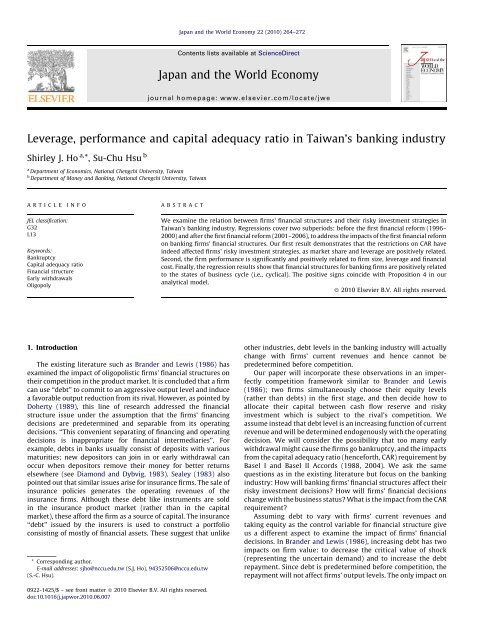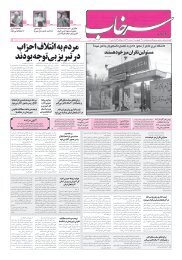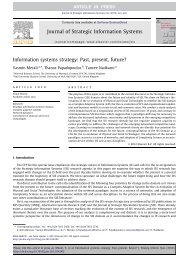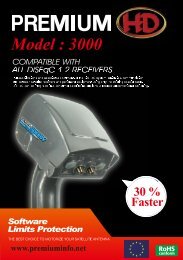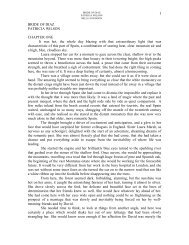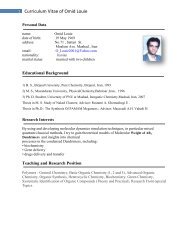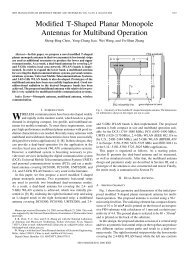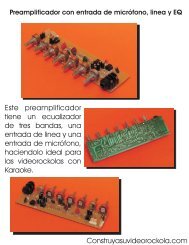Leverage, performance and capital adequacy ratio in Taiwan's ...
Leverage, performance and capital adequacy ratio in Taiwan's ...
Leverage, performance and capital adequacy ratio in Taiwan's ...
You also want an ePaper? Increase the reach of your titles
YUMPU automatically turns print PDFs into web optimized ePapers that Google loves.
Japan <strong>and</strong> the World Economy 22 (2010) 264–272<br />
Contents lists available at ScienceDirect<br />
Japan <strong>and</strong> the World Economy<br />
journal homepage: www.elsevier.com/locate/jwe<br />
<strong>Leverage</strong>, <strong>performance</strong> <strong>and</strong> <strong>capital</strong> <strong>adequacy</strong> <strong>ratio</strong> <strong>in</strong> Taiwan’s bank<strong>in</strong>g <strong>in</strong>dustry<br />
Shirley J. Ho a, *, Su-Chu Hsu b<br />
a Department of Economics, National Chengchi University, Taiwan<br />
b Department of Money <strong>and</strong> Bank<strong>in</strong>g, National Chengchi University, Taiwan<br />
ARTICLE<br />
INFO<br />
ABSTRACT<br />
JEL classification:<br />
G32<br />
L13<br />
Keywords:<br />
Bankruptcy<br />
Capital <strong>adequacy</strong> <strong>ratio</strong><br />
F<strong>in</strong>ancial structure<br />
Early withdrawals<br />
Oligopoly<br />
We exam<strong>in</strong>e the relation between firms’ f<strong>in</strong>ancial structures <strong>and</strong> their risky <strong>in</strong>vestment strategies <strong>in</strong><br />
Taiwan’s bank<strong>in</strong>g <strong>in</strong>dustry. Regressions cover two subperiods: before the first f<strong>in</strong>ancial reform (1996–<br />
2000) <strong>and</strong> after the first f<strong>in</strong>ancial reform (2001–2006), to address the impacts of the first f<strong>in</strong>ancial reform<br />
on bank<strong>in</strong>g firms’ f<strong>in</strong>ancial structures. Our first result demonstrates that the restrictions on CAR have<br />
<strong>in</strong>deed affected firms’ risky <strong>in</strong>vestment strategies, as market share <strong>and</strong> leverage are positively related.<br />
Second, the firm <strong>performance</strong> is significantly <strong>and</strong> positively related to firm size, leverage <strong>and</strong> f<strong>in</strong>ancial<br />
cost. F<strong>in</strong>ally, the regression results show that f<strong>in</strong>ancial structures for bank<strong>in</strong>g firms are positively related<br />
to the states of bus<strong>in</strong>ess cycle (i.e., cyclical). The positive signs co<strong>in</strong>cide with Proposition 4 <strong>in</strong> our<br />
analytical model.<br />
ß 2010 Elsevier B.V. All rights reserved.<br />
1. Introduction<br />
The exist<strong>in</strong>g literature such as Br<strong>and</strong>er <strong>and</strong> Lewis (1986) has<br />
exam<strong>in</strong>ed the impact of oligopolistic firms’ f<strong>in</strong>ancial structures on<br />
their competition <strong>in</strong> the product market. It is concluded that a firm<br />
can use ‘‘debt’’ to commit to an aggressive output level <strong>and</strong> <strong>in</strong>duce<br />
a favorable output reduction from its rival. However, as po<strong>in</strong>ted by<br />
Doherty (1989), this l<strong>in</strong>e of research addressed the f<strong>in</strong>ancial<br />
structure issue under the assumption that the firms’ f<strong>in</strong>anc<strong>in</strong>g<br />
decisions are predeterm<strong>in</strong>ed <strong>and</strong> separable from its operat<strong>in</strong>g<br />
decisions. ‘‘This convenient separat<strong>in</strong>g of f<strong>in</strong>anc<strong>in</strong>g <strong>and</strong> operat<strong>in</strong>g<br />
decisions is <strong>in</strong>appropriate for f<strong>in</strong>ancial <strong>in</strong>termediaries’’. For<br />
example, debts <strong>in</strong> banks usually consist of deposits with various<br />
maturities; new depositors can jo<strong>in</strong> <strong>in</strong> or early withdrawal can<br />
occur when depositors remove their money for better returns<br />
elsewhere (see Diamond <strong>and</strong> Dybvig, 1983). Sealey (1983) also<br />
po<strong>in</strong>ted out that similar issues arise for <strong>in</strong>surance firms. The sale of<br />
<strong>in</strong>surance policies generates the operat<strong>in</strong>g revenues of the<br />
<strong>in</strong>surance firms. Although these debt like <strong>in</strong>struments are sold<br />
<strong>in</strong> the <strong>in</strong>surance product market (rather than <strong>in</strong> the <strong>capital</strong><br />
market), these afford the firm as a source of <strong>capital</strong>. The <strong>in</strong>surance<br />
‘‘debt’’ issued by the <strong>in</strong>surers is used to construct a portfolio<br />
consist<strong>in</strong>g of mostly of f<strong>in</strong>ancial assets. These suggest that unlike<br />
* Correspond<strong>in</strong>g author.<br />
E-mail addresses: sjho@nccu.edu.tw (S.J. Ho), 94352506@nccu.edu.tw<br />
(S.-C. Hsu).<br />
other <strong>in</strong>dustries, debt levels <strong>in</strong> the bank<strong>in</strong>g <strong>in</strong>dustry will actually<br />
change with firms’ current revenues <strong>and</strong> hence cannot be<br />
predeterm<strong>in</strong>ed before competition.<br />
Our paper will <strong>in</strong>corporate these observations <strong>in</strong> an imperfectly<br />
competition framework similar to Br<strong>and</strong>er <strong>and</strong> Lewis<br />
(1986); two firms simultaneously choose their equity levels<br />
(rather than debts) <strong>in</strong> the first stage, <strong>and</strong> then decide how to<br />
allocate their <strong>capital</strong> between cash flow reserve <strong>and</strong> risky<br />
<strong>in</strong>vestment which is subject to the rival’s competition. We<br />
assume <strong>in</strong>stead that debt level is an <strong>in</strong>creas<strong>in</strong>g function of current<br />
revenue <strong>and</strong> will be determ<strong>in</strong>ed endogenously with the operat<strong>in</strong>g<br />
decision. We will consider the possibility that too many early<br />
withdrawal might cause the firms go bankruptcy, <strong>and</strong> the impacts<br />
from the <strong>capital</strong> <strong>adequacy</strong> <strong>ratio</strong> (henceforth, CAR) requirement by<br />
Basel I <strong>and</strong> Basel II Accords (1988, 2004). We ask the same<br />
questions as <strong>in</strong> the exist<strong>in</strong>g literature but focus on the bank<strong>in</strong>g<br />
<strong>in</strong>dustry: How will bank<strong>in</strong>g firms’ f<strong>in</strong>ancial structures affect their<br />
risky <strong>in</strong>vestment decisions? How will firms’ f<strong>in</strong>ancial decisions<br />
change with the bus<strong>in</strong>ess status? What is the impact from the CAR<br />
requirement?<br />
Assum<strong>in</strong>g debt to vary with firms’ current revenues <strong>and</strong><br />
tak<strong>in</strong>g equity as the control variable for f<strong>in</strong>ancial structure give<br />
us a different aspect to exam<strong>in</strong>e the impact of firms’ f<strong>in</strong>ancial<br />
decisions. In Br<strong>and</strong>er <strong>and</strong> Lewis (1986), <strong>in</strong>creas<strong>in</strong>g debt has two<br />
impacts on firm value: to decrease the critical value of shock<br />
(represent<strong>in</strong>g the uncerta<strong>in</strong> dem<strong>and</strong>) <strong>and</strong> to <strong>in</strong>crease the debt<br />
repayment. S<strong>in</strong>ce debt is predeterm<strong>in</strong>ed before competition, the<br />
repayment will not affect firms’ output levels. The only impact on<br />
0922-1425/$ – see front matter ß 2010 Elsevier B.V. All rights reserved.<br />
doi:10.1016/j.japwor.2010.06.007
S.J. Ho, S.-C. Hsu / Japan <strong>and</strong> the World Economy 22 (2010) 264–272 265<br />
the critical value of shock is to lift up the expected dem<strong>and</strong>,<br />
<strong>in</strong>crease marg<strong>in</strong>al revenue, <strong>and</strong> <strong>in</strong>crease output <strong>and</strong> profit.<br />
Hence, debt f<strong>in</strong>anc<strong>in</strong>g can commit a firm to an aggressive output<br />
stance. In our model, the equity level will be set prior to the risky<br />
competition. Equity issu<strong>in</strong>g has three impacts on firm value. First,<br />
higher equity level can <strong>in</strong>crease a firm’s cash flow reserve, which<br />
also decreases the critical value of shock. The former <strong>in</strong>creases<br />
the firm value directly <strong>and</strong> the latter will lift up the expected<br />
dem<strong>and</strong> <strong>and</strong> marg<strong>in</strong>al revenue, <strong>and</strong> also <strong>in</strong>crease risky <strong>in</strong>vestments<br />
<strong>and</strong> returns. Second, higher equity level means more<br />
dividends to give away to equityholders, <strong>and</strong> this will decrease<br />
the marg<strong>in</strong>al revenue, their <strong>in</strong>vestments <strong>and</strong> returns. The third<br />
impact is on the debt repayment, <strong>in</strong>directly through its impacts<br />
on the return <strong>and</strong> the debt level.<br />
For the comb<strong>in</strong>ation of the three effects, Proposition 3<br />
concludes that equity issu<strong>in</strong>g will decrease firms’ equilibrium<br />
risky <strong>in</strong>vestments, show<strong>in</strong>g the dom<strong>in</strong>ation of the latter two<br />
impacts. Proposition 4 also demonstrates that the equilibrium<br />
equity level is higher <strong>in</strong> a better bus<strong>in</strong>ess status. F<strong>in</strong>ally, Basel I <strong>and</strong><br />
Basel II Accords (1988, 2004) suggested that bank<strong>in</strong>g firms should<br />
follow a m<strong>in</strong>imum risk-based <strong>capital</strong> requirement that the CAR be<br />
at least greater than 8%. Proposition 5 shows that if the CAR<br />
requirement is b<strong>in</strong>d<strong>in</strong>g, then the result from Proposition 3 will be<br />
overturned <strong>and</strong> the equilibrium risky <strong>in</strong>vestment will be<br />
positively related to equity level. This gives us an alternative<br />
<strong>in</strong>terpretation for the empirical tests on bank<strong>in</strong>g <strong>in</strong>dustry: if the<br />
risky <strong>in</strong>vestment or return is negatively related to equity level,<br />
then the CAR requirement is not effectively b<strong>in</strong>d<strong>in</strong>g; otherwise,<br />
the CAR requirement is b<strong>in</strong>d<strong>in</strong>g <strong>and</strong> firms’ risk managements are<br />
affected.<br />
We then test our theoretical results us<strong>in</strong>g panel data from<br />
Taiwan’s bank<strong>in</strong>g <strong>in</strong>dustry. Our research is the first attempt to<br />
cover Taiwan’s four core f<strong>in</strong>ancial bus<strong>in</strong>esses: 1 banks, securities<br />
firms, property <strong>in</strong>surance firms <strong>and</strong> life <strong>in</strong>surance firms. We<br />
present the regression results for before the first f<strong>in</strong>ancial reform<br />
(1996–2000) <strong>and</strong> after the first f<strong>in</strong>ancial reform (2001–2006), to<br />
exam<strong>in</strong>e the impacts of the first f<strong>in</strong>ancial reform on bank<strong>in</strong>g firms’<br />
f<strong>in</strong>ancial structure. Our results first justify our theoretical<br />
assumption that debts are <strong>in</strong>creas<strong>in</strong>g function of firms’ returns.<br />
Next, as described by Proposition 5, the restrictions on CAR have<br />
<strong>in</strong>deed affected firms’ management strategies, as market share <strong>and</strong><br />
leverage are positively related. The firm values are significantly<br />
<strong>and</strong> positively related to firm size, leverage <strong>and</strong> f<strong>in</strong>ancial cost.<br />
F<strong>in</strong>ally, the regression results show that f<strong>in</strong>ancial structures for<br />
bank<strong>in</strong>g firms are positively related to the states of bus<strong>in</strong>ess cycle<br />
(i.e., cyclical). The positive signs co<strong>in</strong>cide with Proposition 4 <strong>in</strong> our<br />
analytical model.<br />
Section 2 describes a two stage game where two firms<br />
simultaneously choose their equity levels first, <strong>and</strong> then allocate<br />
their <strong>capital</strong> between cash flow reserves <strong>and</strong> risky <strong>in</strong>vestments,<br />
which are subject to the rival’s competition. Section 3 provides the<br />
empirical tests of our theoretical results us<strong>in</strong>g data from Taiwan’s<br />
bank<strong>in</strong>g <strong>in</strong>dustry. Section 4 concludes the paper.<br />
2. The analytical model<br />
We consider a two stage game between firm 1 <strong>and</strong> 2. In the first<br />
stage, the two firms simultaneously choose the levels of equity e i<br />
(with a face value v i ), which together with an <strong>in</strong>itial debt level D 0 i<br />
determ<strong>in</strong>ed by, say, firm i’s last period revenue, compose firm i’s<br />
<strong>in</strong>itial <strong>capital</strong> stock ðe i v i þ D 0 i Þ <strong>in</strong> the first stage.2 Each firm acts like<br />
a portfolio manager who allocates the received <strong>capital</strong> between<br />
cash flow reserve <strong>and</strong> risky <strong>in</strong>vestment, which is subject to the<br />
1 See the Act of F<strong>in</strong>ancial Hold<strong>in</strong>gs Companies, Article 4, Term 1–3.<br />
2 It is assumed that there is no other <strong>in</strong>ternal <strong>capital</strong>.<br />
rival’s competition. That is, <strong>in</strong> the second stage the two firms<br />
simultaneously choose their levels of risky <strong>in</strong>vestment which is<br />
characterized by a differentiated market with uncerta<strong>in</strong> dem<strong>and</strong>.<br />
This <strong>in</strong>vestment is assumed irreversible <strong>and</strong> the return will be<br />
realized at the end of stage 2.<br />
Denote r i as firm i’s risky <strong>in</strong>vestment, <strong>and</strong> the rema<strong>in</strong><strong>in</strong>g <strong>capital</strong><br />
e i v i þ D 0 i<br />
r i is hence the <strong>in</strong>itial cash flow reserve. The risky<br />
<strong>in</strong>vestment is characterized by a differentiated market with<br />
uncerta<strong>in</strong> dem<strong>and</strong>. Denote p i (r i , r 2 , e i ) as the return for this risky<br />
<strong>in</strong>vestment, which is the difference between revenue <strong>and</strong> variable<br />
cost: p i (r 1 , r 2 , e i )=P i (r 1 , r 2 , e i )r i c i (r i ). The r<strong>and</strong>om variable e i<br />
represents firm i’s state of dem<strong>and</strong>, which is identically <strong>and</strong><br />
<strong>in</strong>dependently distributed on the <strong>in</strong>terval ½e; ēŠ accord<strong>in</strong>g to a<br />
distribution function G(e i ) with density g(e i ).<br />
We will make the conventional assumptions on dem<strong>and</strong> <strong>and</strong><br />
cost functions: @P i /@r i < 0, @P i /@r j < 0, @ 2 P i /@r i r j < 0, @c i /@r i > 0<br />
<strong>and</strong> @ 2 c i =@ri 2 0. This assumption describes that firm i’s <strong>in</strong>verse<br />
dem<strong>and</strong> function is decreas<strong>in</strong>g <strong>in</strong> both r i <strong>and</strong> r j , <strong>and</strong> the cost is<br />
<strong>in</strong>creas<strong>in</strong>g <strong>and</strong> convex <strong>in</strong> its <strong>in</strong>vestment. In addition, we assume<br />
that higher values of e i will lead to higher dem<strong>and</strong> <strong>and</strong> the marg<strong>in</strong>al<br />
dem<strong>and</strong> is higher <strong>in</strong> better states of the world, that is, @P i /@e i > 0<br />
<strong>and</strong> @ 2 P i /@r i e i > 0. As an illustrative example for this differentiated<br />
competition, consider the follow<strong>in</strong>g l<strong>in</strong>ear dem<strong>and</strong> <strong>and</strong> quadratic<br />
cost functions: P i (r 1 , r 2 , e i )r i = a br i gr i + e i <strong>and</strong> c i ðr i Þ¼ri 2=2.<br />
Under these assumptions, the return on risky <strong>in</strong>vestment has the<br />
conventional properties: @ 2 p i =@ri 2 < 0, @ 2 p i /@r i @e i = 0 <strong>and</strong> @ 2 p i /<br />
@r i @r j < 0.<br />
Two specific issues will be discussed: the impact of the CAR<br />
requirement <strong>and</strong> the possibility of early deposit withdrawal. First,<br />
Basel I <strong>and</strong> Basel II Accords 3 (1988, 2004) suggested that firms<br />
should follow a m<strong>in</strong>imum risk-based <strong>capital</strong> requirement that the<br />
CAR, a <strong>ratio</strong> of <strong>capital</strong> over risky credit exposures, be at least greater<br />
than 8%:<br />
e i v i<br />
p i ðr 1 ; r 2 ; e i Þ 0:08; that is; p iðr 1 ; r 2 ; e i Þ12:5ðe i v i Þ (1)<br />
Given e i <strong>and</strong> that p i (r 1 , r 2 , e i ) is concave, if the requirement is<br />
b<strong>in</strong>d<strong>in</strong>g, there will be a lower <strong>and</strong> upper bounds on r i . S<strong>in</strong>ce only<br />
the upper bound can affect the determ<strong>in</strong>ation of equilibrium, we<br />
will focus on this case <strong>and</strong> denote this upper bound by ¯r i ðr j ; e i Þ.<br />
Proposition 1. The upper bound from the CAR requirement ¯r i ðr j ; e i Þ is<br />
<strong>in</strong>creas<strong>in</strong>g <strong>in</strong> e i <strong>and</strong> decreas<strong>in</strong>g <strong>in</strong> r j . 4<br />
Accord<strong>in</strong>g to Diamond <strong>and</strong> Dybvig (1983), the withdrawal<br />
decision will depend on the firm’s current revenue, dem<strong>and</strong><br />
uncerta<strong>in</strong>ty <strong>and</strong> other depositors’ withdrawal decisions. Under the<br />
first-come-first-serve rule, early withdrawers can fully retrieve<br />
their money until the firm’s cash flow reserve is used up, then the<br />
firm declares bankruptcy <strong>and</strong> the debtholders get the rema<strong>in</strong><strong>in</strong>g<br />
value. To simplify, we will eschew the detailed discussion on<br />
depositors’ withdrawal decisions, <strong>and</strong> assume directly that the<br />
rema<strong>in</strong><strong>in</strong>g debt is D i (p i (r 1 , r 2 , e i )). S<strong>in</strong>ce the amount of withdrawal<br />
will depend on firm’s current revenue, the rema<strong>in</strong><strong>in</strong>g debt is<br />
therefore a function of current revenue. For simplification, we<br />
assume that D 0 i > 0 <strong>and</strong> D00 i < 0, mean<strong>in</strong>g that higher return can<br />
attract more deposits but <strong>in</strong> a decreas<strong>in</strong>g rate.<br />
Recall that firm i’s <strong>in</strong>itial cash flow reserve is e i v i þ D 0 i<br />
r i .<br />
Notice that the amount of early withdrawal ½D 0 i<br />
D i ðp i ðr 1 ; r 2 ; e i ÞÞŠ<br />
can also be negative <strong>and</strong> be <strong>in</strong>terpreted as deposit <strong>in</strong>crease. The<br />
current cash flow reserve becomes e i v i þ D 0 i<br />
r i ½D 0 i<br />
D i ðp i ðr 1 ; r 2 ; e i ÞÞŠ or <strong>in</strong> short, e i v i þ D i ðp i ðr 1 ; r 2 ; e i ÞÞ r i . There is a<br />
3 See http://en.wikipedia.org/wiki/Capital_<strong>adequacy</strong>_<strong>ratio</strong>#cite_note-<strong>in</strong>vestopedia-0.<br />
4 The detailed characterization for the analytical results is referred to Ho <strong>and</strong> Hsu<br />
(2010).
266<br />
S.J. Ho, S.-C. Hsu / Japan <strong>and</strong> the World Economy 22 (2010) 264–272<br />
level of debt associated with each value of p i (r 1 , r 2 , e i ), until e i drops<br />
down to e 1 (e i , r 1 , r 2 ), when the amount of early debt withdrawal<br />
exceeds the cash flow reserve. e 1 (e i , r 1 , r 2 ) is the critical value of<br />
r<strong>and</strong>om shock for the breakeven condition, given by<br />
e i v i þ D i ðp i ðr 1 ; r 2 ; e i ÞÞ r i ¼ 0 (2)<br />
The firm will announce bankruptcy when e i < e 1 (e i , r 1 , r 2 ) <strong>and</strong> we<br />
will assume that e < e 1 ðe i ; r 1 ; r 2 Þ < ē.<br />
Proposition 2. e 1 (e i , r 1 , r 2 ) is decreas<strong>in</strong>g <strong>in</strong> e i , <strong>and</strong> decreas<strong>in</strong>g <strong>and</strong><br />
convex <strong>in</strong> r i .<br />
The bankruptcy probability G(e 1 (e i , r 1 , r 2 )) will be decreas<strong>in</strong>g<br />
<strong>in</strong> e i , <strong>and</strong> decreas<strong>in</strong>g <strong>and</strong> convex <strong>in</strong> r i . However, we need to<br />
compare e 1 (e i , r 1 , r 2 ) with the critical value def<strong>in</strong>ed <strong>in</strong> Br<strong>and</strong>er<br />
<strong>and</strong> Lewis’ (1986) Eq. (2), which describes the breakeven<br />
condition for firm value. In our portfolio choice framework,<br />
the firm value consists of the return from risky <strong>in</strong>vestment <strong>and</strong><br />
cash flow reserve. In addition, there are two k<strong>in</strong>ds of <strong>capital</strong><br />
costs: the dividends paid to equityholders <strong>and</strong> the repayment to<br />
debtholders. For simplification, these <strong>capital</strong> prices are assumed<br />
to be competitive <strong>and</strong> exogenously given. That is, let u i be the<br />
share of return given to equityholders as dividends <strong>and</strong> f i be the<br />
<strong>in</strong>terest rate paid to debtholders. 5 In good states (to be def<strong>in</strong>ed<br />
shortly), the total amount of repayment paid to debtholders is<br />
(1 + f i )D i (p i ), <strong>and</strong> equityholders get dividends from what is left<br />
after debtholders’ claims, i.e., e i u i [p i (r 1 , r 2 , e i ) (1 + f i )D i (p i )].<br />
Overall, firm i’s value is:<br />
f½p i ðr 1 ; r 2 ; e i Þþe i v i þ D i ðp i ðr 1 ; r 2 ; e i ÞÞ r i Š e i u i ½p i ðr 1 ; r 2 ; e i Þ<br />
ð1 þ f i ÞD i ðp i ðr 1 ; r 2 ; e i ÞÞŠ ½ð1 þ f i ÞD i ðp i ðr 1 ; r 2 ; e i ÞÞŠg:<br />
The first square bracket denotes the sum of the return on risky<br />
<strong>in</strong>vestment <strong>and</strong> cash flow reserve. The second square bracket<br />
conta<strong>in</strong>s the total dividends, <strong>and</strong> the third bracket conta<strong>in</strong>s the<br />
repayment to debtholders.<br />
Let e 2 (e i , r 1 , r 2 ) denote the critical value of shock for Eq. (3) to<br />
be zero. The difference between Eqs. (2) <strong>and</strong> (3), i.e., p i (r 1 , r 2 ,<br />
e i ) e i u i [p i (r 1 , r 2 , e i ) (1 + f i )D i (p i (r 1 , r 2 , e i ))] (1 + f i )D i (p i (r 1 ,<br />
r 2 , e i )), can be either positively or negatively related to e i ,<br />
depend<strong>in</strong>g on the relative<br />
<br />
sizes of e i u i p 0 i<br />
<strong>and</strong> D 0 i . Hence we<br />
will def<strong>in</strong>e eðe i ; r 1 ; r 2 Þmax e 1 ðe i ; r 1 ; r 2 Þ; e 1 ðe i ; r 1 ; r 2 Þ . It can be<br />
checked that eðe i ; r 1 ; r 2 Þ is decreas<strong>in</strong>g <strong>in</strong> e i , <strong>and</strong> decreas<strong>in</strong>g <strong>and</strong><br />
convex <strong>in</strong> r i .<br />
Overall, <strong>in</strong> good states when e i eðe i ; r 1 ; r 2 Þ, the firm value is as<br />
given by Eq. (3); <strong>in</strong> bad states when e i < eðe i ; r 1 ; r 2 Þ, the firm will<br />
declare bankruptcy, so the firm value will be zero. The expected<br />
firm value is hence<br />
Z ē<br />
W i ¼ f½p i ðr 1 ; r 2 ; e i Þþe i v i þ D i ðp i ðr 1 ; r 2 ; e i ÞÞ r i Š<br />
eðe i ;r 1 ;r 2 Þ<br />
e i u i ½p i ðr 1 ; r 2 ; e i Þ ð1 þ f i ÞD i ðp i ðr 1 ; r 2 ; e i ÞÞŠ<br />
½ð1 þ f i ÞD i ðp i ðr 1 ; r 2 ; e i ÞÞŠgdGðe i Þ<br />
Alternatively, the value function can be rewritten as:<br />
Z ē<br />
W i ¼ fð1-e i u i Þ½p i ðr 1 ; r 2 ; e i Þ ð1 þ f i ÞD i ðp i ðr 1 ; r 2 ; e i ÞÞŠ<br />
eðe i ;r 1 ;r 2 Þ<br />
þ e i v i þ D i ðp i ðr 1 ; r 2 ; e i ÞÞ r i gdGðe i Þ: (4)<br />
5 We have not considered the effect of big equity holders, which is believed to<br />
cause the managers to choose risky assets.<br />
We have treated firms like portfolio managers, so the firm value<br />
conta<strong>in</strong>s both the return from risky <strong>in</strong>vestment <strong>and</strong> the cash<br />
flow reserve. The <strong>in</strong>teg<strong>ratio</strong>n <strong>in</strong> the expected value is taken from<br />
eðe i ; r 1 ; r 2 Þ till ē. Br<strong>and</strong>er <strong>and</strong> Lewis (1986) called this part of<br />
value as the equity value. They have dist<strong>in</strong>guished between<br />
equityholders <strong>and</strong> debtholders; due to limited liability, equityholders<br />
are residual claimants <strong>in</strong> good states <strong>and</strong> debtholders<br />
become residual claimants <strong>in</strong> bad states. Br<strong>and</strong>er <strong>and</strong> Lewis<br />
compared the maximiz<strong>in</strong>g results for both equity value<br />
(<strong>in</strong>tegrated from eðe i ; r 1 ; r 2 Þ to ē) <strong>and</strong> debt value (<strong>in</strong>tegrated<br />
from e to eðe i ; r 1 ; r 2 Þ). They concluded that the output level <strong>in</strong><br />
debt value is obviously below that <strong>in</strong> equity value. Differently,<br />
Showalter (1995) <strong>and</strong> Wanzenried (2003) assumed that firms<br />
act on behalf of equityholders <strong>in</strong> the second stage, so the output<br />
level is chosen to maximize the equity value. However, <strong>in</strong> the<br />
first stage, firms choose the debt level to maximize the full<br />
value, where the <strong>in</strong>teg<strong>ratio</strong>n is taken from e to ē. Showalter<br />
(1995) expla<strong>in</strong>ed that this is so because debtholders can<br />
anticipate the output decisions by firms, <strong>and</strong> change accord<strong>in</strong>gly<br />
the cost of funds. So firms should <strong>in</strong>ternalize the compet<strong>in</strong>g<br />
<strong>in</strong>terests between debtholders <strong>and</strong> equityholders, <strong>and</strong> choose<br />
debt to maximize the full value of the firm. Instead, Wanzenried<br />
(2003) expla<strong>in</strong>ed that, s<strong>in</strong>ce the potential debtholders are<br />
foresighted, the firms need to present the overall value<br />
<strong>in</strong>clud<strong>in</strong>g the possibility of bankruptcy when sell<strong>in</strong>g bonds to<br />
raise funds.<br />
By backward <strong>in</strong>duction, we first derive the equilibrium risky<br />
<strong>in</strong>vestments, <strong>and</strong> then determ<strong>in</strong>e the first stage equity levels us<strong>in</strong>g<br />
the second stage results.<br />
2.1. Analytical results<br />
Given the f<strong>in</strong>ancial decision e i , firm i’s maximization conditions<br />
are given by @W i /@r i = 0 <strong>and</strong> @ 2 W i =@r 2 i<br />
< 0, the latter of which is<br />
satisfied under our assumptions. Let r i (r j ,e i ) be firm i’s best<br />
response function <strong>and</strong> Proposition 3 describes the properties of<br />
r i (r j ,e i ).<br />
Proposition 3. r i (r j ,e i ) is negatively related to r j <strong>and</strong> e i .<br />
That is, we have the conventional downward slopp<strong>in</strong>g reaction<br />
function, <strong>and</strong> e i <strong>in</strong>creases, r i (r j ,e i ) shifts toward the left. The<br />
equilibrium risky <strong>in</strong>vestment ðr1 ; r 2Þ is given by<br />
r i<br />
2 r j ðr i ; e jÞ for i; j ¼ 1; 2: Notice that Proposition 3 also<br />
describes that the equilibrium risky <strong>in</strong>vestment is negatively<br />
related to e i . Recall that <strong>in</strong> Br<strong>and</strong>er <strong>and</strong> Lewis (1986), firms choose<br />
debt levels prior to product competition. S<strong>in</strong>ce the debt level is<br />
predeterm<strong>in</strong>ed <strong>and</strong> constant, the only impact of debt is to lift up<br />
the expected dem<strong>and</strong>, <strong>and</strong> <strong>in</strong>crease output <strong>and</strong> profit. Hence, firm’s<br />
outputs or profits will <strong>in</strong>crease with f<strong>in</strong>ancial leverage, which is<br />
measured by a debt to equity or value <strong>ratio</strong>. In our model, firms<br />
choose the level of e i prior to competition <strong>in</strong> risky <strong>in</strong>vestment. e i<br />
has three impacts on firm value: to <strong>in</strong>crease the cash flow reserve<br />
which also decreases critical value of shock, to <strong>in</strong>crease the<br />
dividends to equityholders, <strong>and</strong> to <strong>in</strong>crease debt level <strong>in</strong>directly<br />
through its impact on the return. Our result shows the dom<strong>in</strong>ation<br />
of the latter two negative effects. However, s<strong>in</strong>ce the debt to equity<br />
<strong>ratio</strong> is negatively related to e i , our result co<strong>in</strong>cides with Br<strong>and</strong>er<br />
<strong>and</strong> Lewis (1986) that firms’ outputs or profits <strong>in</strong> risky <strong>in</strong>vestment<br />
are positively related to f<strong>in</strong>ancial leverage.<br />
Despite that <strong>in</strong>creas<strong>in</strong>g e i is dom<strong>in</strong>ated for the risky<br />
<strong>in</strong>vestment market, there are still positive impacts on the cash<br />
flow reserve <strong>and</strong> <strong>in</strong>directly on debt. Given the equilibrium risky<br />
<strong>in</strong>vestment ðr1 ; r 2Þ, the equilibrium equity level is determ<strong>in</strong>ed by<br />
@W i ðe i ; r1 ; r 2 Þ=e i ¼ 0.<br />
Next, we show that the equilibrium equity level is higher <strong>in</strong> a<br />
better bus<strong>in</strong>ess status. To exam<strong>in</strong>e the effect of different bus<strong>in</strong>ess<br />
status, we consider a distribution Ĝ which stochastically dom<strong>in</strong>ates<br />
G <strong>in</strong> the sense that Ĝðe i Þ < Gðe i Þ, for e i eðe i ; r 1 ; r 2 Þ <strong>and</strong> we<br />
will demonstrate that the equilibrium e i is greater under Ĝ.<br />
Proposition 4. The equilibrium equity level is higher <strong>in</strong> a better<br />
bus<strong>in</strong>ess status.
S.J. Ho, S.-C. Hsu / Japan <strong>and</strong> the World Economy 22 (2010) 264–272 267<br />
F<strong>in</strong>ally we exam<strong>in</strong>e how the CAR requirement from the Basel I<br />
<strong>and</strong> II Accord affects the relation between risky <strong>in</strong>vestment <strong>and</strong><br />
f<strong>in</strong>ancial structure. Recall from Eq. (1) that the CAR requirement<br />
puts an upper bound on the level of risky <strong>in</strong>vestment: ¯r i ðr j ; e i Þ,<br />
which is <strong>in</strong>creas<strong>in</strong>g <strong>in</strong> e i <strong>and</strong> decreas<strong>in</strong>g <strong>in</strong> r j . Together with<br />
Proposition 3 that r i (r j ,e i ) is negatively related to e i , this <strong>in</strong>dicates<br />
that the response function is k<strong>in</strong>ked at the level ¯r i ðr j ; e i Þ. S<strong>in</strong>ce<br />
¯r i ðr j ; e i Þ will decrease with r j , the restricted part is not constant.<br />
Proposition 5 describes the relation between risky <strong>in</strong>vestment <strong>and</strong><br />
e i , if the CAR requirement is b<strong>in</strong>d<strong>in</strong>g.<br />
Proposition 5. If the CAR requirement is b<strong>in</strong>d<strong>in</strong>g, then the equilibrium<br />
risky <strong>in</strong>vestment will be positively related to e i .<br />
With CAR b<strong>in</strong>d<strong>in</strong>g, each firm <strong>in</strong>creases equity issu<strong>in</strong>g <strong>and</strong> its<br />
risky <strong>in</strong>vestment. Together with Proposition 3, this result gives us<br />
an <strong>in</strong>terest<strong>in</strong>g implication for empirical tests on bank<strong>in</strong>g <strong>in</strong>dustry:<br />
if the firm’s risky <strong>in</strong>vestment or return is negatively related to<br />
equity level, then the CAR requirement is not effectively b<strong>in</strong>d<strong>in</strong>g;<br />
otherwise, the CAR requirement is b<strong>in</strong>d<strong>in</strong>g <strong>and</strong> the firm’s risk<br />
management is affected by this constra<strong>in</strong>t.<br />
3. Regressions <strong>and</strong> results<br />
Due to high leverages, the bank<strong>in</strong>g <strong>in</strong>dustry is often treated<br />
as a special case by literature <strong>and</strong> receives little attention.<br />
Nevertheless, its highly correlation with other <strong>in</strong>dustries <strong>and</strong><br />
large contribution to GDP 6 have motivated us to reexam<strong>in</strong>e the<br />
feasibility of the exist<strong>in</strong>g models <strong>in</strong> Section 2. Inthissectionwe<br />
will provide empirical supports by test<strong>in</strong>g the theoretical results<br />
us<strong>in</strong>g data from Taiwan’s bank<strong>in</strong>g <strong>in</strong>dustry for the period 1996–<br />
2006. Our data cover two subperiods: 1996–2000 <strong>and</strong> 2001–<br />
2006, <strong>and</strong> the cutt<strong>in</strong>g po<strong>in</strong>t is the year of ‘‘the first f<strong>in</strong>ancial<br />
reform’’. After the 1997 South Asia f<strong>in</strong>ancial crisis, the Executive<br />
Yuan of Taiwan approved of ‘‘the Act of F<strong>in</strong>ancial Reform Fund’’<br />
<strong>in</strong> 2001 to improve the health<strong>in</strong>ess of the bank<strong>in</strong>g <strong>in</strong>dustry. 7<br />
Sequential activities <strong>in</strong>clude: to reach the so called‘‘258 targets’’,<br />
namely, to reduce overdue loans <strong>ratio</strong> to 5% <strong>and</strong> to <strong>in</strong>crease<br />
<strong>capital</strong> <strong>adequacy</strong> <strong>ratio</strong> to 8% <strong>in</strong> 2 years. More importantly, the<br />
government promoted the establishment of f<strong>in</strong>ancial hold<strong>in</strong>gs<br />
companies to encourage mergers <strong>and</strong> acquisitions among the<br />
exist<strong>in</strong>g firms, which greatly changed the risky <strong>in</strong>vestment<br />
strategies <strong>in</strong> this <strong>in</strong>dustry. In order to exam<strong>in</strong>e the impacts<br />
of the first f<strong>in</strong>ancial reform on bank<strong>in</strong>g firms’ f<strong>in</strong>ancial<br />
structure <strong>and</strong> <strong>in</strong>vestment strategies, we test for the subperiods<br />
before the first reform (1996–2000) <strong>and</strong> after the first reform<br />
(2001–2006).<br />
3.1. Data <strong>and</strong> variables<br />
Our research is the first attempt to cover four core f<strong>in</strong>ancial<br />
bus<strong>in</strong>esses: banks, securities firms, property <strong>in</strong>surance firms <strong>and</strong><br />
life <strong>in</strong>surance firms <strong>in</strong> Taiwan. We extract the data of banks <strong>and</strong><br />
securities companies from the Taiwan Economic Journal Data<br />
Bank (TEJ), <strong>and</strong> the data of life <strong>and</strong> property <strong>in</strong>surance<br />
companies from the Insurance Year Book, issued by Taiwan<br />
Insurance Research Center. There are overall 44 banks, 31<br />
securities companies, 17 property <strong>in</strong>surance companies <strong>and</strong> 15<br />
life <strong>in</strong>surance companies. Notice that we have used panel data<br />
which, accord<strong>in</strong>g to Hsiao (1986), can <strong>in</strong>crease sample numbers,<br />
trace the <strong>in</strong>tertemporal variation of <strong>in</strong>dividual firms <strong>and</strong><br />
<strong>in</strong>crease the estimation efficiency.<br />
6 The bank<strong>in</strong>g <strong>in</strong>dustries contributed over 10.04% of GDP <strong>in</strong> Taiwan. Data source:<br />
2008 National Income Statistics by the Census Bureau.<br />
7 Related laws <strong>and</strong> regulations <strong>in</strong>clude the F<strong>in</strong>ancial Hold<strong>in</strong>g Company Act, the<br />
F<strong>in</strong>ancial Institutions Merger Law, the Company Law, the Securities Exchange Law.<br />
The def<strong>in</strong>itions of variables are given as follows. A summary of<br />
sample firms <strong>and</strong> statistics is presented <strong>in</strong> Appendix (Tables A.1–<br />
A.5). The currency used for these variables is one thous<strong>and</strong> new<br />
Taiwan dollars (NTDS).<br />
Asset: Total Asset is used to measure firm size (see Smith <strong>and</strong><br />
Watts, 1992; Campello, 2003).<br />
Cost1: F<strong>in</strong>ancial expense. For banks, f<strong>in</strong>ancial expense refers to<br />
<strong>in</strong>terest expenses or bad debts write-off; for securities companies,<br />
it refers to total expenditure m<strong>in</strong>us ope<strong>ratio</strong>nal expense <strong>and</strong> nonoperat<strong>in</strong>g<br />
expense; for <strong>in</strong>surance companies, it refers to the<br />
allowance for liability reserve.<br />
Cost2: Operat<strong>in</strong>g expenses <strong>in</strong>clude sell<strong>in</strong>g expenses, adm<strong>in</strong>istrative<br />
expenses <strong>and</strong> other expenses such as research <strong>and</strong> development<br />
expense, salaries, rents, taxes, depreciations/amortization,<br />
uncollectible accounts <strong>and</strong> other miscellaneous expenses.<br />
Debt: Total debt represents firms’ total external debt.<br />
MS: Market share is the <strong>ratio</strong> of each firm’s net operat<strong>in</strong>g<br />
revenue over the <strong>in</strong>dustrial sum of net revenues. Greenhalgh <strong>and</strong><br />
Rogers (2006) reported that companies with large market shares<br />
have more monopoly power <strong>and</strong> hence may not need to cost down<br />
when it faces challengers.<br />
Rev: Net operat<strong>in</strong>g revenues are firms’ revenues m<strong>in</strong>us sales<br />
returns <strong>and</strong> allowances.<br />
RevR: State of bus<strong>in</strong>ess is the growth rate of net operat<strong>in</strong>g<br />
revenues (Rev). Campello (2003) used log DGDP to <strong>in</strong>dicate the<br />
state of bus<strong>in</strong>ess, but this <strong>in</strong>dustry wise <strong>in</strong>dex cannot identify the<br />
difference across firms. For our aim, we use RevR, each firm’s<br />
revenue growth rates, to <strong>in</strong>dicate the bus<strong>in</strong>ess state faced by<br />
<strong>in</strong>dividual firms.<br />
ROE: Return on equity is the per share pretax net profit. This term<br />
measures bank<strong>in</strong>g firms’ management efficiency.<br />
Stock: Value of common stock. In Taiwan, the m<strong>in</strong>imum required<br />
<strong>capital</strong> is 10 billions NTDs for commercial banks, 2 billions NTDs for<br />
<strong>in</strong>surance companies, <strong>and</strong> 60 billions NTDs for f<strong>in</strong>ancial hold<strong>in</strong>gs<br />
companies.<br />
3.2. Regression models<br />
Proposition 3 <strong>in</strong> Section 2 describes that if CAR is not b<strong>in</strong>d<strong>in</strong>g,<br />
output <strong>and</strong> equity level are negatively related; while Proposition<br />
5 says that when CAR is b<strong>in</strong>d<strong>in</strong>g, output <strong>and</strong> equity level<br />
are positively related. Hence, Eq. (5) tests if the risky<br />
<strong>in</strong>vestment strategies for Taiwan’s bank<strong>in</strong>g firms are affected<br />
by CAR:<br />
MS ¼ b 0 þ b 1 logðStockÞþe 0 : (5)<br />
If b 1 is negative, then we can conclude as Br<strong>and</strong>er <strong>and</strong> Lewis (1986)<br />
that leverage is negatively related to market share, <strong>in</strong>dicat<strong>in</strong>g that<br />
the risky <strong>in</strong>vestment is not affected by CAR. Otherwise, if b 1 is<br />
positive, then as stated by Proposition 5, the leverage is positively<br />
related to market share, <strong>in</strong>dicat<strong>in</strong>g that CAR is actually <strong>in</strong>fluenc<strong>in</strong>g<br />
the risky <strong>in</strong>vestment strategy.<br />
Second, we use Eq. (6) to exam<strong>in</strong>e the relationship between<br />
firm’s <strong>performance</strong>, firm size, state of bus<strong>in</strong>ess, f<strong>in</strong>ancial structure,<br />
costs <strong>and</strong> management efficiency.<br />
log ðRevÞ ¼g 0 þ g 1 logðAssetÞþg 2 Re þ g 3 logðStockÞ<br />
þ g 4 logðCost1Þþg 5 logðCost2Þþg 6 ROE þ e 0 : (6)<br />
First of all, bigger firm size <strong>in</strong>dicates higher monopoly power,<br />
<strong>and</strong> hence g 1 is expected to be positive. Similarly, when a<br />
bank<strong>in</strong>g firm is <strong>in</strong> a better state, there is less chance for<br />
bankruptcy <strong>and</strong> hence the public is more will<strong>in</strong>g to deposit or<br />
purchase <strong>in</strong>surance. These activities either directly <strong>in</strong>crease<br />
<strong>performance</strong> or <strong>in</strong>crease transactions with banks, <strong>and</strong> hence g 2<br />
is expected to be positive.
268<br />
S.J. Ho, S.-C. Hsu / Japan <strong>and</strong> the World Economy 22 (2010) 264–272<br />
As described, more deposits or higher <strong>in</strong>surance premiums<br />
not only <strong>in</strong>crease debt levels, but also <strong>in</strong>crease firms’ revenues.<br />
This expla<strong>in</strong>s our assumption about the positive relationship<br />
between debt level <strong>and</strong> revenue. To underst<strong>and</strong> the overall<br />
relationship between bank<strong>in</strong>g firms’ revenue <strong>and</strong> f<strong>in</strong>ancial<br />
structure, we need to exam<strong>in</strong>e the sign of g 3 . Moreover, s<strong>in</strong>ce<br />
market share is positively related to a firm’s revenue, the sign of<br />
g 3 is also related to b 1 <strong>in</strong> Eq. (5); namely,ifg 3 is positive, then as<br />
stated by our Proposition 5, the leverage is positively related<br />
to market share (hence revenue), <strong>in</strong>dicat<strong>in</strong>g that CAR is<br />
actually <strong>in</strong>fluenc<strong>in</strong>g the risky <strong>in</strong>vestment <strong>in</strong> Taiwan’s bank<strong>in</strong>g<br />
<strong>in</strong>dustry.<br />
Next, Cost1 measures the f<strong>in</strong>ancial expense such as <strong>in</strong>terest<br />
expenses or debts write-off. S<strong>in</strong>ce the <strong>in</strong>terest rates are often<br />
publicly announced, the average f<strong>in</strong>ancial expenses are not too<br />
different across firms, <strong>and</strong> therefore the total f<strong>in</strong>ancial expense<br />
will be positively related to firm’s output <strong>and</strong> revenues,<br />
<strong>in</strong>dicat<strong>in</strong>g a positive sign for g 4 . Similarly, Cost2 conta<strong>in</strong>s total<br />
ope<strong>ratio</strong>nal expenditures such as salaries <strong>and</strong> advertisement<br />
fees. The average ope<strong>ratio</strong>nal costs are not too different across<br />
firms, <strong>and</strong> hence Cost2 is positively related to revenues,<br />
<strong>in</strong>dicat<strong>in</strong>g a positive sign for g 5 . F<strong>in</strong>ally, ROE is <strong>in</strong>cluded to<br />
measure management efficiency, which is expected to have<br />
positive contribution to firm values.<br />
F<strong>in</strong>ally, Eq. (7) exam<strong>in</strong>es whether bank<strong>in</strong>g firms’ f<strong>in</strong>ancial<br />
structures are affected by firm size <strong>and</strong> the bus<strong>in</strong>ess state.<br />
logðStockÞ ¼u 0 þ u 1 logðAssetÞþu 2 Re þ e 0 (7)<br />
S<strong>in</strong>ce bigger firm sizes <strong>in</strong>dicate higher monopoly power <strong>and</strong><br />
cheaper average costs due to economy of scale, firms could<br />
preempt the market by extend<strong>in</strong>g their <strong>capital</strong> <strong>and</strong> hence u 1 is<br />
expected to be positive. We also use each firm’s revenue growth<br />
rates to <strong>in</strong>dicate the bus<strong>in</strong>ess state faced by <strong>in</strong>dividual firm. In bad<br />
states, firms will reduce loans <strong>and</strong> the public will reduce stock<br />
transactions or will<strong>in</strong>gness to purchase <strong>in</strong>surance, which then<br />
suggests a positive sign for u 2 .<br />
3.3. Results<br />
As described, we have used panel data to <strong>in</strong>crease sample<br />
numbers, to trace the <strong>in</strong>tertemporal variation of <strong>in</strong>dividual firms,<br />
<strong>and</strong> to <strong>in</strong>crease the estimation efficiency. However, due to the<br />
emergence of 14 f<strong>in</strong>ancial hold<strong>in</strong>gs companies s<strong>in</strong>ce 2001, the<br />
sample lengths for firms are not exactly the same <strong>and</strong> hence the<br />
panel data are unbalanced. The software used to run regressions<br />
for Eqs. (5)–(7) is Eviews.<br />
The literature has provided three approaches 8 to h<strong>and</strong>le<br />
panel data: pooled data regression, fixed effect model <strong>and</strong> r<strong>and</strong>om<br />
effect model. Follow<strong>in</strong>g Greene (2003), wefirstexam<strong>in</strong>etheFvalues<br />
for Eqs. (5)–(7), which significantly reject the null<br />
hypotheses that the firm specific dummy variables are identical<br />
across firms. Next, the Hausman tests significantly suggest that<br />
thedataarebestfit<strong>in</strong>thefixedeffectmodel.S<strong>in</strong>ceourma<strong>in</strong><br />
concern is on the impact of f<strong>in</strong>ancial structure, we will eschew<br />
the detailed econometric discussion to avoid distraction <strong>and</strong> to<br />
save space. We will present ‘‘the fixed effect’’ ord<strong>in</strong>ary least<br />
squared (OLS) results <strong>in</strong> Tables 1–3. NoticethatTables A.2–A.5<br />
show that the correlations between Debt <strong>and</strong> Rev for banks,<br />
securities firms, life <strong>in</strong>surance firms <strong>and</strong> property <strong>in</strong>surance<br />
firms are 0.8775, 0.8345, 0.9424 <strong>and</strong> 0.9571, respectively, which<br />
hence justifies our assumption that debt is positively related to<br />
revenue.<br />
8 See Waldfogel (1997) <strong>and</strong> Greene (2003).<br />
Table 1<br />
Capital structure <strong>and</strong> market share (OLS fixed effect).<br />
MS<br />
1996–2000 2001–2006<br />
Banks Securities Life <strong>in</strong>surance Property <strong>in</strong>surance Banks Securities Life <strong>in</strong>surance Property <strong>in</strong>surance<br />
C 0.039065 * ( 1.585201) 0.037331 (0.999297) 0.080303 (1.294085) 0.117344 *** (2.788879) 0.165105 *** ( 3.856054) 0.183211 *** ( 3.693341) 0.016750 ( 0.143058) 0.131364 * ( 1.516185)<br />
log (Stock) 0.004000 *** (2.658128) 0.000379 (0.154574) 0.001063 ( 0.260506) 0.004106 ( 1.396752) 0.011482 *** (4.439376) 0.013990 *** (4.449621) 0.005257 (0.699510) 0.013194 ** (2.258427)<br />
Adj. R 2 0.978502 0.909464 0.991336 0.962830 0.929400 0.937765 0.982245 0.971288<br />
F-statistic 200.0014 *** 39.50692 *** 565.4651 *** 128.9918 *** 72.50585 *** 78.28447 *** 329.2392 *** 184.0741 ***<br />
Obs. 189 116 75 85 240 160 90 93<br />
Numbers <strong>in</strong> parentheses <strong>in</strong>dicate the t-values.<br />
*<br />
Significance level 10%.<br />
**<br />
Significance level 5%.<br />
***<br />
Significance level 1%.
Table 2<br />
Firm value, leverage <strong>and</strong> other variables (OLS fixed effect).<br />
log (Rev)<br />
1996–2000 2001–2006<br />
Banks Securities Life <strong>in</strong>surance Property <strong>in</strong>surance Banks Securities Life <strong>in</strong>surance Property <strong>in</strong>surance<br />
C 1.224072 ** (2.199697) 1.041137 ( 1.347804) 0.775220 * (1.595234) 1.085429 ( 1.286633) 6.398643 *** (4.683181) 1.572893 ** ( 2.221610) 0.179686 ( 0.988163) 0.820488 * (1.570679)<br />
log (Asset) 0.096188 *** (2.697794) 0.076392 * (1.478833) 0.170306 *** (3.608257) 0.158758 ** (2.083030) 0.030025 (0.975445) 0.027456 (0.591584) 0.021590 (1.264930) 0.038586 * (1.514695)<br />
RevR 0.076820 *** (6.550538) 0.004569 ( 0.618490) 0.105506 *** (3.600036) 0.010832 *** ( 2.565268) 0.289383 *** (5.353928) 0.023445 *** (2.859412) 0.006708 (0.803483) 0.050286 * (1.593330)<br />
log (Stock) 0.169341 *** (4.813069) 0.244151 *** (4.863010) 0.030024 ( 1.256812) 0.006761 ( 0.213268) 0.157202 * ( 1.764470) 0.143764 ** (2.144235) 0.006619 ( 0.454385) 0.020835 (0.741104)<br />
log (Cost1) 0.365247 *** (29.18049) 0.215698 *** (9.865457) 0.721327 *** (15.89881) 0.772409 *** (19.35464) 0.394377 *** (12.76780) 0.188115 *** (11.93068) 0.947693 *** (48.27325) 0.768646 *** (22.28338)<br />
log (Cost2) 0.321662 *** (9.617355) 0.551683 *** (14.26035) 0.096392 *** (2.981488) 0.176668 *** (3.526550) 0.380750 *** (5.386598) 0.768199 *** (13.51201) 0.057975 *** (7.060449) 0.153959 *** (6.019474)<br />
ROE 0.025274 *** (4.914365) 0.092833 *** (13.38813) 0.007426 *** (3.366926) 0.023977 *** (4.132608) 0.038198 *** (5.442209) 0.217914 *** (13.53819) 0.010029 *** (9.855373) 0.017098 *** (5.616848)<br />
Adj.R 2 0.998569 0.995240 0.999237 0.997329 0.976385 0.991057 0.999794 0.996227<br />
F-statistic 2215.581 *** 523.7028 *** 3864.714 *** 1138.021 *** 200.9803 *** 487.3662 *** 21622.18 *** 1105.146 ***<br />
Obs. 147 86 60 68 238 159 90 93<br />
Numbers <strong>in</strong> parentheses <strong>in</strong>dicate the t-values.<br />
* Significance level 10%.<br />
** Significance level 5%.<br />
*** Significance level 1%.<br />
Table 3<br />
Capital structure, firm size <strong>and</strong> bus<strong>in</strong>ess state (OLS fixed effect).<br />
log (Stock)<br />
1996–2000 2001–2006<br />
Banks Securities Life <strong>in</strong>surance Property <strong>in</strong>surance Banks Securities Life <strong>in</strong>surance Property <strong>in</strong>surance<br />
C 3.945341 ** (2.471725) 3.485510 *** (2.922911) 9.775536 *** (4.448777) 9.843195 *** ( 3.079411) 14.83508 *** (27.99260) 7.606362 *** (8.007508) 11.95521 *** (17.46457) 11.00254 *** (7.705996)<br />
log (Asset) 0.657646 *** (7.865125) 0.691907 *** (9.399773) 0.322740 ** (2.528063) 1.525920 *** (7.587557) 0.089474 *** (3.252236) 0.479068 *** (8.264222) 0.195915 *** (5.316006) 0.237708 *** (2.677695)<br />
RevR 0.008998 (0.245682) 7.43E 08 *** (4.195364) 0.005509 ( 0.033650) 0.044483 *** (2.699550) 0.124731 *** (2.774586) 1.61E 08 (0.977079) 0.037886 (0.642949) 0.078883 (0.648674)<br />
Adj. R 2 0.953513 0.890851 0.896584 0.935315 0.959192 0.959420 0.967741 0.948179<br />
F-statistic 72.30077 *** 31.27768 *** 32.96957 *** 54.82149 *** 124.7937 *** 118.4744 *** 167.8695 *** 94.51932 ***<br />
Obs. 147 116 60 68 238 160 90 93<br />
Numbers <strong>in</strong> parentheses <strong>in</strong>dicate the t-values.<br />
* Significance level 10%.<br />
** Significance level 5%.<br />
*** Significance level 1%.<br />
S.J. Ho, S.-C. Hsu / Japan <strong>and</strong> the World Economy 22 (2010) 264–272 269
270<br />
S.J. Ho, S.-C. Hsu / Japan <strong>and</strong> the World Economy 22 (2010) 264–272<br />
First, Table 1 presents the fixed effect OLS results for Eq. (5) for<br />
four bus<strong>in</strong>esses <strong>in</strong> two subperiods. By exam<strong>in</strong><strong>in</strong>g the sign of b 1<br />
(Stock), we can conclude whether bank<strong>in</strong>g firms’ risky <strong>in</strong>vestment<br />
strategies are affected by the regulations of CAR; if CAR regulation<br />
is b<strong>in</strong>d<strong>in</strong>g, then as described by Proposition 5, market share is<br />
positively related to stock (b 1 > 0); otherwise, as described by<br />
Proposition 3 <strong>in</strong> this paper <strong>and</strong> by Br<strong>and</strong>er <strong>and</strong> Lewis (1986),<br />
market share is negatively related to stock (b 1 < 0). The F-values<br />
are significant for all four bus<strong>in</strong>esses <strong>in</strong> two subperiods. The values<br />
of adjusted R-squared are all above 0.9.<br />
Before the reform, b 1 is only significantly positive for banks<br />
<strong>and</strong> it is even slightly negative for property <strong>in</strong>surance firms but<br />
not significantly; after the reform, the magnitude of b 1 has<br />
<strong>in</strong>creased for all four bus<strong>in</strong>esses, <strong>and</strong> it is significantly positive<br />
for banks, securities <strong>and</strong> property <strong>in</strong>surance firms. The positive<br />
sign of b 1 after the f<strong>in</strong>ancial reform suggests that bank<strong>in</strong>g firms’<br />
risk <strong>in</strong>vestment strategies are affected by the regulations on<br />
CAR. The establishment of f<strong>in</strong>ancial hold<strong>in</strong>gs companies has<br />
strengthened the regulation impacts; The Act of F<strong>in</strong>ancial<br />
Hold<strong>in</strong>gs Company requires that the CAR for the hold<strong>in</strong>gs<br />
companies be at least 100%, with<strong>in</strong> which the CAR must be<br />
at least 10% for bank subord<strong>in</strong>ates, 200% for securities<br />
subord<strong>in</strong>ates <strong>and</strong> 300% for <strong>in</strong>surance subord<strong>in</strong>ates. These<br />
rules are much stricter than those for each <strong>in</strong>dividual bus<strong>in</strong>ess, 9<br />
<strong>and</strong> hence cause more distortion to <strong>in</strong>vestment after the<br />
reform.<br />
Second, Eq. (6) exam<strong>in</strong>es the relationship between <strong>performance</strong>,<br />
asset size, bus<strong>in</strong>ess state, f<strong>in</strong>ancial structure, costs, <strong>and</strong><br />
management efficiency. Table 2 presents the fixed effect OLS<br />
results for the two subperiods. The F-values are all significant <strong>and</strong><br />
the adjusted R-squared values are all above 0.97.<br />
Before the reform, g 1 (Asset) is positive <strong>and</strong> significant for all<br />
four bus<strong>in</strong>esses; after the reform, the magnitude of g 1 all<br />
decreases, <strong>and</strong> it is only significantly positive for property<br />
<strong>in</strong>surance firms. A positive sign of g 1 shows that bigger firm size<br />
<strong>in</strong>dicates higher monopoly power, which can also be expla<strong>in</strong>ed<br />
as the economy of scale effect. After the establishment of many<br />
f<strong>in</strong>ancial hold<strong>in</strong>g firms <strong>in</strong> 2001, firms tend to compete <strong>in</strong><br />
diversification by provid<strong>in</strong>g more customized <strong>and</strong> bundled<br />
services. In other words, the economy of scope effect becomes<br />
more important, <strong>and</strong> this could be part of reasons why the scale<br />
effects are weaker after the reform. Next, for both before <strong>and</strong><br />
after the reform, g 2 (RevR) is positive for banks <strong>and</strong> life<br />
<strong>in</strong>surance firms, <strong>in</strong>dicat<strong>in</strong>g that <strong>in</strong> better states the public is<br />
more will<strong>in</strong>g to deposit or purchase <strong>in</strong>surance, which either<br />
directly <strong>in</strong>creases firm value or <strong>in</strong>creases transactions with<br />
banks. For securities <strong>and</strong> property <strong>in</strong>surance firms, g 2 is negative<br />
before the reform <strong>and</strong> turns significantly positive after the<br />
reform. A possible explanation is that, before the reform, firms<br />
kept part of revenues as reta<strong>in</strong>ed <strong>capital</strong> to meet the CAR<br />
requirement, so <strong>in</strong> better states, more money was reta<strong>in</strong>ed. After<br />
the reform when the requirement was met, we have the<br />
expected results like banks <strong>and</strong> life <strong>in</strong>surance firms.<br />
Recall that we have assumed debt to be positively related to<br />
revenue. The coefficient of g 3 (Stock) will show the overall<br />
impact of leverage on firm value. g 3 is significantly positive for<br />
banks <strong>and</strong> securities firms before the reform, <strong>and</strong> it turns<br />
significantly negative after the reform for banks. However, for<br />
property <strong>in</strong>surance firms, the opposite results occur. Accord<strong>in</strong>g<br />
to Proposition 3, when CAR is b<strong>in</strong>d<strong>in</strong>g, market share (hence firm<br />
value) is positively related to stock, <strong>and</strong> it is negative for<br />
otherwise. It is <strong>in</strong>terest<strong>in</strong>g to underst<strong>and</strong> why <strong>in</strong>surance firms<br />
are not affected by the CAR requirement before the reform,<br />
9 For <strong>in</strong>dividual firms, the CAR must be at least 8% for banks, 150% for securities<br />
companies <strong>and</strong> 200% for <strong>in</strong>surance companies.<br />
while banks are not affected after the reform. For <strong>in</strong>surance<br />
firms, a possible reason could be that, <strong>in</strong> the subperiod before<br />
the reform the <strong>capital</strong> requirement is only 2 billions NTDs, while<br />
after the reform, the CAR requirement <strong>in</strong>creases to 200%, which<br />
greatly restricts firms’ risky <strong>in</strong>vestment levels, <strong>and</strong> hence it<br />
becomes b<strong>in</strong>d<strong>in</strong>g after the reform. On the other h<strong>and</strong>, s<strong>in</strong>ce a<br />
large number of banks are merged <strong>in</strong>to f<strong>in</strong>ancial hold<strong>in</strong>g<br />
companies after the reform, the CAR requirement for the whole<br />
f<strong>in</strong>ancial hold<strong>in</strong>g companies can be shared by other subsidiaries,<br />
<strong>and</strong> hence it is not b<strong>in</strong>d<strong>in</strong>g for banks alone after the reform.<br />
Next, as expected, the cost terms g 4 (Cost1) <strong>and</strong> g 5 (Cost2)<br />
are significantly positive for all bus<strong>in</strong>ess before <strong>and</strong> after the<br />
reform. F<strong>in</strong>ally, g 6 (ROE) is positive for all bus<strong>in</strong>ess for both<br />
subperiods, support<strong>in</strong>g the positive contribution of management<br />
efficiency.<br />
Eq. (7) exam<strong>in</strong>es the relationship between firms’ f<strong>in</strong>ancial<br />
structure, firm size <strong>and</strong> bus<strong>in</strong>ess state. Table 3 presents the fixed<br />
effect OLS results for the two subperiods. The F-values are<br />
significant for all four bus<strong>in</strong>esses <strong>in</strong> two subperiods. The adjusted<br />
R-squared values are all above 0.89.<br />
For both subperiods, u 1 (Asset) is significantly positive with<strong>in</strong> 1%<br />
confidence level for all four bus<strong>in</strong>esses. This supports the idea that<br />
firms could preempt the market by extend<strong>in</strong>g their <strong>capital</strong>, to take<br />
advantage of the benefit from economy of scale. Next, u 2 (bus<strong>in</strong>ess<br />
state) is positive for banks, securities firms <strong>and</strong> property <strong>in</strong>surance<br />
firms before <strong>and</strong> after the reform. For life <strong>in</strong>surance firms, it is<br />
negative but not significant before the reform, <strong>and</strong> it is also positive<br />
after the reform. The positive signs co<strong>in</strong>cide with Proposition 4 <strong>in</strong><br />
our analytical model.<br />
4. Conclud<strong>in</strong>g remarks<br />
This paper <strong>in</strong>corporates the observation that <strong>in</strong> the bank<strong>in</strong>g<br />
<strong>in</strong>dustry, debts are usually affected by current revenues <strong>and</strong> cannot<br />
be predeterm<strong>in</strong>ed before competition. In a portfolio choice model,<br />
we have analyzed how two firms sequentially decide their<br />
f<strong>in</strong>ancial structures through choos<strong>in</strong>g equity level, <strong>and</strong> then the<br />
level of risky <strong>in</strong>vestment which is subject to the rival’s competition.<br />
Tak<strong>in</strong>g equity as a control variable gives us a different aspect<br />
to exam<strong>in</strong>e the impact from firms’ f<strong>in</strong>ancial decisions; <strong>in</strong> addition<br />
to the impact on the critical value of shock from uncerta<strong>in</strong> dem<strong>and</strong>,<br />
the firms’ f<strong>in</strong>ancial decisions also affect firms’ cash flow reserve, as<br />
well as the costs paid to equityholders <strong>and</strong> debtholders. Our ma<strong>in</strong><br />
results show that leverage is positively related to a firm’s revenue;<br />
however, when the CAR requirement is b<strong>in</strong>d<strong>in</strong>g, this result will be<br />
overturned. This gives us a convenient approach to check if the<br />
firm’s risky <strong>in</strong>vestment strategy is restricted by the CAR requirement,<br />
by test<strong>in</strong>g the relationship between firm’s f<strong>in</strong>ancial structure<br />
<strong>and</strong> risky <strong>in</strong>vestment.<br />
Our theoretical results are tested us<strong>in</strong>g panel data from<br />
Taiwan’s bank<strong>in</strong>g <strong>in</strong>dustry. Our research is the first attempt to<br />
cover Taiwan’s four core f<strong>in</strong>ancial bus<strong>in</strong>esses: banks, securities<br />
firms, life <strong>in</strong>surance firms <strong>and</strong> property <strong>in</strong>surance firms. The first<br />
result agrees with Proposition 5 that the restrictions on CAR have<br />
<strong>in</strong>deed affected firms’ management strategies, as market share <strong>and</strong><br />
leverage are positively related. Second, firm values are significantly<br />
<strong>and</strong> positively related to firm size, leverage <strong>and</strong> f<strong>in</strong>ancial cost.<br />
F<strong>in</strong>ally, the regression results show that f<strong>in</strong>ancial structures for<br />
bank<strong>in</strong>g firms are positively related to the states of bus<strong>in</strong>ess cycle<br />
(i.e., cyclical). The positive signs co<strong>in</strong>cide with Proposition 4 <strong>in</strong> our<br />
analytical model.<br />
Appendix A. Appendix<br />
See Tables A.1–A.5.
S.J. Ho, S.-C. Hsu / Japan <strong>and</strong> the World Economy 22 (2010) 264–272 271<br />
Table A.1<br />
Sample companies.<br />
Bank Securities Life <strong>in</strong>surance Property <strong>in</strong>surance<br />
Chang Hwa Com. Bank, First Com. Bank, Polaris, President, Bank of Taiwan, First,<br />
Hua Nan Com. Bank, Ch<strong>in</strong>a Dev. Ind. Bank, MasterL<strong>in</strong>k, Capital, Taiwan, PCA., Taiwan Fire Mar<strong>in</strong>e,<br />
Mega Int. Com. Bank, Ch<strong>in</strong>atrust Com. Bank, KGI, Taiwan Int., Ch<strong>in</strong>a, Nan Shan, Walsum,<br />
Taichung Com. Bank, Yuanta Secur. F<strong>in</strong>ance, Horizon, Global, Tacomar,<br />
Bank of Communication, Cathay United Bank,<br />
Concord, Mass Mutual Zurich (Taiwan),<br />
Agricultural Bank of Taiwan, Taiwan Bus. Bank,<br />
Gr<strong>and</strong> Bills Com. Bank, Dah An Com. Bank, Tachan, Ta Ch<strong>in</strong>g., Mercuries, Sh<strong>in</strong>kong,<br />
Taipei Fubon Com. Bank, Cathay Com. Bank, Ta Chong, Yuanta Sh<strong>in</strong>ung, S<strong>in</strong>gfor, Union,<br />
Bank S<strong>in</strong>oPac, E. Sun Com. Bank, Fubon Com. Core Pacific, Far Glory, AIG (Taiwan),<br />
Bank, Yuanta Com. Bank, Taish<strong>in</strong> Int. Bank, S<strong>in</strong>oPac, Hontai, Cathay, Toyko Mariane,<br />
Sh<strong>in</strong> Kong Com. Bank, Jih Sun Int. Bank, K<strong>in</strong>g’s Gr<strong>and</strong> Cathay, Sh<strong>in</strong> Kong, Newa,<br />
Town Bank, Taichung Com. Bank, Bank of Fuhwa, Fubon, Allianz Taiwan, Kuo Hua,<br />
Kaohsiung, Cosmos Bank, Union Bank of Taiwan, Hua Nan, Taish<strong>in</strong>, Fubon. Fubon,<br />
Far Eastern Int. bank, Taipei Int. Com. Bank, Jih Sun, First Taiwan, First, Ch<strong>in</strong>atrust, Pali, Chung Kuo,<br />
Taiwan L<strong>and</strong> Dev. Corp., Ta Chong Bank, Mega, Waterl<strong>and</strong>, MSIG M<strong>in</strong>gtai,<br />
EnTie Com. Bank, Taiwan Coop. Bank, K-W-S, Sh<strong>in</strong> Kong, Cathay Century,<br />
Industrial Bank of Taiwan, First Capital Com. E. Sun, Cathay, Union,<br />
Bank, Serventh Com. Bank, Int. Bills, Ti Don., Concourse. South Ch<strong>in</strong>a.<br />
Ch<strong>in</strong>a Bills, Mega Bills, E. Sun Bills,<br />
Ch<strong>in</strong>atrust Bills, Taish<strong>in</strong> Bills, Hu Nan Bills.<br />
Table A.2<br />
Variables statistics (banks).<br />
Asset Cost1 Cost2 Debt Rev RevR ROE MS Stock<br />
Mean 394,000,000 14,779,930 4,558,998 365,000,000 20,723,722 0.07 0.81 0.0256 18,675,751<br />
Median 204,000,000 8,972,994 2,707,811 188,000,000 12,444,786 0.03 1.12 0.0146 15,380,144<br />
Maximum 2,370,000,000 79,008,305 28,391,058 2,280,000,000 99,459,299 4.76 11.16 0.1367 86,784,220<br />
M<strong>in</strong>imum 5,263,160 75,392 39,183 100,260 201,373 0.91 9.97 0.0002 1,586,750<br />
Std. Dev. 444,000,000 16,535,814 4,824,263 425,000,000 21,216,150 0.36 2.47 0.0259 13,962,402<br />
Skewness 1.69 1.82 1.67 1.72 1.51 6.43 1.67 1.44 1.88<br />
Kurtosis 5.35 6.13 6.08 5.51 4.70 79.35 9.15 4.47 8.15<br />
Obs. 433 430 431 433 431 385 431 429 433<br />
Variables correlations (banks)<br />
Asset Cost1 Cost2 Debt Rev RevR ROE MS Stock<br />
Asset 1.0000<br />
Cost1 0.8268 1.0000<br />
Cost2 0.8940 0.8251 1.0000<br />
Debt 0.9989 0.8256 0.8912 1.0000<br />
Rev 0.8840 0.9223 0.9180 0.8775 1.0000<br />
RevR 0.0656 0.0882 0.0249 0.0709 0.0156 1.0000<br />
ROE 0.0618 0.1475 0.0692 0.0526 0.1436 0.2188 1.0000<br />
MS 0.9144 0.9047 0.9438 0.9086 0.9886 0.0261 0.1369 1.0000<br />
Stock 0.5997 0.5045 0.5842 0.5650 0.5733 0.0317 0.0215 0.5962 1.0000<br />
Table A.3<br />
Variables statistics (securities).<br />
Asset Cost1 Cost2 Debt Rev RevR ROE MS Stock<br />
Mean 29,488,414 940,718 1,790,251 18,627,671 3,584,968 0.33 1.18 0.0399 7,511,986<br />
Median 22,871,826 608,501 1,705,400 14,332,841 2,930,197 0.05 1.11 0.0368 5,611,743<br />
Maximum 143,000,000 8,217,645 5,750,926 82,187,239 18,129,963 13.50 8.14 0.1575 31,898,730<br />
M<strong>in</strong>imum 122,969 6,172 4,273 690 16,267 0.55 2.45 0.0001 270,000<br />
Std. Dev. 25,274,380 1,015,091 1,268,172 16,331,005 2,937,630 1.35 1.54 0.0313 5,715,924<br />
Skewness 1.39 2.49 0.58 1.12 1.08 7.03 1.10 0.78 1.52<br />
Kurtosis 5.67 13.59 2.71 4.02 4.59 60.74 6.08 3.14 6.07<br />
Obs. 277 276 277 277 276 245 276 276 276<br />
Variables correlation (securities)<br />
Asset Cost1 Cost2 Debt Rev RevR ROE MS Stock<br />
Asset 1.0000<br />
Cost1 0.6349 1.0000<br />
Cost2 0.8934 0.6258 1.0000<br />
Debt 0.9714 0.6490 0.8337 1.0000<br />
Rev 0.8805 0.7789 0.9323 0.8345 1.0000<br />
RevR 0.1181 0.0587 0.1297 0.1049 0.0622 1.0000<br />
ROE 0.2618 0.1082 0.3231 0.2647 0.4575 0.2217 1.0000<br />
MS 0.8707 0.7330 0.9294 0.8267 0.9794 0.0743 0.4718 1.0000<br />
Stock 0.9167 0.5224 0.8578 0.8286 0.7822 0.1591 0.0902 0.7667 1.0000
272<br />
S.J. Ho, S.-C. Hsu / Japan <strong>and</strong> the World Economy 22 (2010) 264–272<br />
Table A.4<br />
Variables statistics (life <strong>in</strong>surance).<br />
Asset Cost1 Cost2 Debt Rev RevR ROE MS Stock<br />
Mean 205,000,000 65,884,995 4,813,383 218,000,000 72,391,339 0.28 0.42 0.0647 8,600,451<br />
Median 48,716,389 19,942,669 1,108,573 47,385,191 20,790,432 0.19 0.06 0.0216 3,900,000<br />
Maximum 2,140,000,000 561,000,000 47,591,477 2,020,000,000 599,000,000 2.21 18.38 0.4831 58,386,158<br />
M<strong>in</strong>imum 1,826,394 860,820 231,583 545,860 1,114,702 0.27 19.69 0.0018 700,000<br />
Std. Dev. 374,000,000 107,000,000 8,394,768 368,000,000 118,000,000 0.34 4.21 0.1047 12,234,350<br />
Skewness 2.75 2.50 2.46 2.37 2.43 2.37 0.49 2.26 2.61<br />
Kurtosis 10.89 9.24 8.95 8.85 8.72 11.18 8.67 7.46 8.95<br />
Obs. 165 165 165 165 165 150 165 165 165<br />
Variables correlation (life <strong>in</strong>surance)<br />
Asset Cost1 Cost2 Debt Rev RevR ROE MS Stock<br />
Asset 1.0000<br />
Cost1 0.9927 1.0000<br />
Cost2 0.8592 0.8643 1.0000<br />
Debt 0.9439 0.9464 0.7874 1.0000<br />
Rev 0.9914 0.9988 0.8849 0.9424 1.0000<br />
RevR 0.2284 0.2176 0.2205 0.1866 0.2192 1.0000<br />
ROE 0.3737 0.4106 0.3177 0.3848 0.4195 0.0670 1.0000<br />
MS 0.8646 0.8895 0.9474 0.8069 0.9076 0.2162 0.4588 1.0000<br />
Stock 0.8945 0.8832 0.9291 0.8323 0.8974 0.2057 0.2634 0.8960 1.0000<br />
Table A.5<br />
Variables statistics (property <strong>in</strong>surance).<br />
Asset Cost1 Cost2 Debt Rev RevR ROE MS Stock<br />
Mean 11,686,197 9,859,880 1,064,745 7,349,788 11,869,796 0.18 0.75 0.0616 3,020,378<br />
Median 9,062,009 8,471,410 847,004 6,061,975 9,918,059 0.04 1.05 0.500 2,000,000<br />
Maximum 77,706,524 40,823,381 4,056,865 38,594,768 47,836,156 10.22 3.78 0.2200 20,747,765<br />
M<strong>in</strong>imum 2,061,160 45,953 70,283 70,510 106,421 0.33 9.42 0.0000 435,000<br />
Std. Dev. 12,837,936 6,976,085 716,416 6,314,782 8,416,738 1.15 1.61 0.433 3,763,520<br />
Skewness 3.35 2.75 2.47 2.72 2.45 8.37 2.12 2.34 3.66<br />
Kurtosis 14.16 10.93 9.14 11.11 9.40 73.27 12.22 8.57 16.18<br />
Obs 178 178 178 178 178 161 178 178 178<br />
Variables correlation (property <strong>in</strong>surance)<br />
Asset Cost1 Cost2 Debt Rev RevR ROE MS Stock<br />
Asset 1.0000<br />
Cost1 0.9396 1.0000<br />
Cost2 0.8454 0.9363 1.0000<br />
Debt 0.9770 0.9362 0.8370 1.0000<br />
Rev 0.9299 0.9514 0.8762 0.9571 1.0000<br />
RevR 0.0943 0.1501 0.1083 0.1396 0.1530 1.0000<br />
ROE 0.2549 0.2355 0.1632 0.3091 0.3106 0.1507 1.0000<br />
MS 0.9304 0.9402 0.8648 0.9518 0.9902 0.1458 0.3121 1.0000<br />
Stock 0.9477 0.8947 0.8431 0.8862 0.8507 0.0338 0.1099 0.8465 1.0000<br />
References<br />
Br<strong>and</strong>er, J.A., Lewis, T., 1986. Oligopoly <strong>and</strong> f<strong>in</strong>ancial structure: the limited liability<br />
effect. American Economic Review 76 (5), 956–970.<br />
Campello, M., 2003. Capital structure <strong>and</strong> product markets <strong>in</strong>teractions:<br />
evidence from bus<strong>in</strong>ess cycles. Journal of F<strong>in</strong>ancial Economics 68 (3),<br />
353–378.<br />
Diamond, D., Dybvig, P., 1983. Bank runs, the rescu<strong>in</strong>g policies, <strong>and</strong> liquidity. Journal<br />
of Political Economy 91, 401–419.<br />
Doherty, N., 1989. On the <strong>capital</strong> structure of <strong>in</strong>surance firms. In: Cumm<strong>in</strong>s, J.D.,<br />
Derrig, R.A. (Eds.), In Chapter 9, F<strong>in</strong>ancial Models of Insurance Solvency.<br />
Spr<strong>in</strong>ger.<br />
Greene, W., 2003. Econometric Analysis, 5th ed. Prentice-Hall, New Jersey.<br />
Greenhalgh, C., Rogers, M., 2006. Trade Marks <strong>and</strong> Market Value <strong>in</strong> UK Firms.<br />
Melbourne Institute Work<strong>in</strong>g Paper Series wp2006n04.<br />
Ho, S.J., Hsu, S.C., 2010. Capital Structure <strong>and</strong> Competition <strong>in</strong> the Bank<strong>in</strong>g Industry:<br />
Theory <strong>and</strong> Empirics. Mimeo. National Chengchi University.<br />
Hsiao, C., 1986. Analysis of Panel Data. Cambridge University Press.<br />
Showalter, D., 1995. Oligopoly <strong>and</strong> f<strong>in</strong>ancial structure: comment. American Economic<br />
Review 85 (3), 647–653.<br />
Sealey Jr., C.W., 1983. Valuation, <strong>capital</strong> structure, <strong>and</strong> shareholder unanimity for<br />
depository f<strong>in</strong>ancial <strong>in</strong>termediaries. The Journal of F<strong>in</strong>ance 38 (3), 857–871.<br />
Smith, C.J., Watts, R.L., 1992. The <strong>in</strong>vestment opportunity set <strong>and</strong> corporate f<strong>in</strong>anc<strong>in</strong>g,<br />
dividend, <strong>and</strong> compensation policies. Journal of F<strong>in</strong>ancial Economics 32 (3),<br />
263–292.<br />
Waldfogel, J., 1997. The effect of children on women’s wages. American Sociological<br />
Review 62 (2), 209–217.<br />
Wanzenried, G., 2003. Capital structure decisions <strong>and</strong> output market competition<br />
under dem<strong>and</strong> uncerta<strong>in</strong>ty. International Journal of Industrial Organization 21<br />
(2), 171–200.


